Measurement Method of Interpupillary Distance and Pupil Height Based on Ensemble of Regression Trees and the BlendMask Algorithm
Abstract
1. Introduction
- (1)
- Capture facial images and process them using image processing techniques;
- (2)
- Use integrated regression tree algorithms to locate the pupils;
- (3)
- Use the BlendMask algorithm to locate the eyeglass frames;
- (4)
- Calculate the pupil distance and height based on defined parameters;
- (5)
- Integrate the above steps into a single model for simultaneous measurement of pupil distance and height;
- (6)
- Compare the values of pupil distance calculated by our model with those measured by a ruler and an auto-refractometer, and analyze the consistency among the three measurement methods.
2. Related Works
2.1. Pupil Detection Technology
2.2. Instance Segmentation Algorithm
3. Methods
3.1. Dataset Collection and Preprocessing
3.2. Pupil Location
3.2.1. Training of the First-Layer Regression
3.2.2. Training of the Second-Layer Regression
3.3. The Network Structure of BlendMask
3.3.1. Top-Layers
3.3.2. Bottom Module
3.3.3. Blender Module
3.3.4. Loss Function Design
3.4. Head Pose Estimation
3.5. The Calculation of Pupil Distance and Pupil Height
3.5.1. Calculation Method of Pupil Distance
3.5.2. Calculation Method for Pupil Height
4. Experimentation and Discussion
4.1. Experimental Environment
4.2. Program Measurement Process
4.3. Pupil Positioning Detection Results
4.4. Glasses Lens Detection Results and Analysis
4.4.1. Training and Evaluation
4.4.2. Results Show
4.5. Visualization of Head Pose Estimation
4.6. Measurement Results of Interpupillary Distance and Pupillary Height
5. Conclusions
Author Contributions
Funding
Institutional Review Board Statement
Informed Consent Statement
Data Availability Statement
Conflicts of Interest
References
- Boraston, Z.; Blakemore, S.J. The application of eye-tracking technology in the study of autism. J. Physiol. 2007, 581, 893–898. [Google Scholar] [CrossRef] [PubMed]
- Kasprowski, P.; Dzierzega, M.; Kruk, K.; Harezlak, K.; Filipek, E. Application of eye tracking to support children’s vision enhancing exercises. In Advances in Intelligent Systems and Computing, Proceedings of the Information Technologies in Medicine: 5th International Conference, ITIB 2016, Kamień Śląski, Poland, 20–22 June 2016 Proceedings, Volume 1; Springer International Publishing: Cham, Switzerland, 2016; pp. 75–84. [Google Scholar]
- Raudonis, V.; Simutis, R.; Narvydas, G. Discrete eye tracking for medical applications. In Proceedings of the 2009 2nd International Symposium on Applied Sciences in Biomedical and Communication Technologies, Bratislava, Slovakia, 24–27 November 2009; pp. 1–6. [Google Scholar]
- Chen, Y.; Tsai, M.J. Eye-hand coordination strategies during active video game playing: An eye-tracking study. Comput. Hum. Behav. 2015, 51, 8–14. [Google Scholar] [CrossRef]
- Chandra, S.; Sharma, G.; Malhotra, S.; Jha, D.; Mittal, A.P. Eye tracking based human computer interaction: Applications and their uses. In Proceedings of the 2015 International Conference on Man and Machine Interfacing (MAMI), Bhubaneswar, India, 17–19 December 2015; pp. 1–5. [Google Scholar]
- Giancoli, D.C.; Miller, I.A.; Puri, O.P.; Zober, P.J.; Zober, G.P. Physics: Principles with Applications; Pearson/Prentice Hall: Upper Saddle River, NJ, USA, 1998. [Google Scholar]
- Yildirim, Y.; Sahbaz, I.; Kar, T.; Kagan, G.; Taner, M.T.; Armagan, I.; Cakici, B. Evaluation of interpupillary distance in the Turkish population. Clin. Ophthalmol. 2015, 9, 1413–1416. [Google Scholar] [CrossRef] [PubMed][Green Version]
- Min-Allah, N.; Jan, F.; Alrashed, S. Pupil detection schemes in human eye: A review. Multimed. Syst. 2021, 27, 753–777. [Google Scholar] [CrossRef]
- Qiu, Y.; Xu, X.; Qiu, L.; Pan, Y.; Wu, Y.; Chen, W.; Han, X. 3dcaricshop: A dataset and a baseline method for single-view 3d caricature face reconstruction. In Proceedings of the IEEE/CVF Conference on Computer Vision and Pattern Recognition, Nashville, TN, USA, 20–25 June 2021; pp. 10236–10245. [Google Scholar]
- Wu, J.; Zhou, Z. Efficient face candidates selector for face detection. Pattern Recognit. 2003, 36, 1175–1186. [Google Scholar] [CrossRef]
- Ban, Y.; Kim, S.-K.; Kim, S.; Toh, K.-A.; Lee, S. Face detection based on skin color likelihood. Pattern Recognit. 2014, 47, 1573–1585. [Google Scholar] [CrossRef]
- Karaaba, M.F.; Schomaker, L.; Wiering, M. Machine learning for multi-view eyepair detection. Eng. Appl. Artif. Intell. 2014, 33, 69–79. [Google Scholar] [CrossRef]
- Long, L. Research on Face Detection and Eye Location Algorithm Based on Adaboost; University of Electronic Science and Technology: Chengdu, China, 2008. (In Chinese) [Google Scholar]
- Lin, M. Research on Face Recognition Based on Deep Learning; Dalian University of Technology: Dalian, China, 2013. (In Chinese) [Google Scholar]
- Wang, C.; Chang, L. A precise eye localization method based on region projection. J. Optoelectron. Laser 2011, 4, 618–622. [Google Scholar]
- Kumar, R.T.; Raja, S.K.; Ramakrishnan, A.G. Eye detection using color cues and projection functions. In Proceedings of the 2002 International Conference on International Conference on Image Processing, Rochester, NY, USA, 22–25 September 2002; Volume 3, pp. 337–340. [Google Scholar]
- Wu, Y.; Yang, Y.; Wang, L.P. An Eye Location Algorithm Based on the Gray Information and the Pupil Filter. Comput. Eng. Appl. 2005, 41, 45–47. [Google Scholar]
- Xu, G.F.; Huang, L.; Liu, C.P.; Ding, S.Q. Eye Location Using Hierarchical Classifier. J. Chin. Comput. Syst. 2008, 29, 1158–1162. [Google Scholar]
- Kazemi, V.; Sullivan, J. One millisecond face alignment with an ensemble of regression trees. In Proceedings of the IEEE Conference on Computer Vision and Pattern Recognition, Columbus, OH, USA, 23–28 June 2014; pp. 1867–1874. [Google Scholar]
- LeCun, Y.; Bengio, Y.; Hinton, G. Deep learning. Nature 2015, 521, 436–444. [Google Scholar] [CrossRef] [PubMed]
- Krizhevsky, A.; Sutskever, I.; Hinton, G.E. Imagenet classification with deep convolutional neural networks. Commun. ACM 2017, 60, 84–90. [Google Scholar]
- Zeiler, M.D.; Fergus, R. Visualizing and understanding convolutional networks. In Lecture Notes in Computer Science, Proceedings of the Computer Vision–ECCV 2014: 13th European Conference, Zurich, Switzerland, 6–12 September 2014, Proceedings, Part I 13; Springer International Publishing: Cham, Switzerland, 2014; pp. 818–833. [Google Scholar]
- He, K.; Gkioxari, G.; Dollár, P.; Girshick, R. Mask r-cnn. In Proceedings of the IEEE International Conference on Computer Vision, Venice, Italy, 22–29 October 2017; pp. 2961–2969. [Google Scholar]
- Girshick, R. Fast r-cnn. In Proceedings of the IEEE International Conference on Computer Vision, Santiago, Chile, 7–13 December 2015; pp. 1440–1448. [Google Scholar]
- Ren, S.; He, K.; Girshick, R.; Sun, J. Faster R-CNN: Towards Real-Time Object Detection with Region Proposal Networks. IEEE Trans. Pattern Anal. Mach. Intell. 2017, 39, 1137–1149. [Google Scholar] [CrossRef] [PubMed]
- Lin, T.Y.; Dollár, P.; Girshick, R.; He, K.; Hariharan, B.; Belongie, S. Feature pyramid networks for object detection. In Proceedings of the IEEE conference on Computer Vision and Pattern Recognition, Honolulu, HI, USA, 21–26 July 2017; pp. 2117–2125. [Google Scholar]
- Lin, T.Y.; Maire, M.; Belongie, S.; Hays, J.; Perona, P.; Ramanan, D.; Dollár, P.; Zitnick, C.L. Microsoft coco: Common objects in context. In Lecture Notes in Computer Science, Proceedings of the Computer Vision–ECCV 2014: 13th European Conference, Zurich, Switzerland, 6–12 September 2014, Proceedings, Part V 13; Springer International Publishing: Cham, Switzerland, 2014; pp. 740–755. [Google Scholar]
- Cordts, M.; Omran, M.; Ramos, S.; Rehfeld, T.; Enzweiler, M.; Benenson, R.; Franke, U.; Roth, S.; Schiele, B. The cityscapes dataset for semantic urban scene understanding. In Proceedings of the IEEE Conference on Computer Vision and Pattern Recognition, Las Vegas, NV, USA, 27–30 June 2016; pp. 3213–3223. [Google Scholar]
- Neuhold, G.; Ollmann, T.; Rota Bulo, S.; Kontschieder, P. The mapillary vistas dataset for semantic understanding of street scenes. In Proceedings of the IEEE International Conference on Computer Vision, Venice, Italy, 22–29 October 2017; pp. 4990–4999. [Google Scholar]
- Hafiz, A.M.; Bhat, G.M. A survey on instance segmentation: State of the art. Int. J. Multimed. Inf. Retr. 2020, 9, 171–189. [Google Scholar] [CrossRef]
- Chen, H.; Sun, K.; Tian, Z.; Shen, C.; Huang, Y.; Yan, Y. Blendmask: Top-down meets bottom-up for instance segmentation. In Proceedings of the IEEE/CVF Conference on Computer Vision and Pattern Recognition, Seattle, WA, USA, 13–19 June 2020; pp. 8573–8581. [Google Scholar]
- Sagonas, C.; Tzimiropoulos, G.; Zafeiriou, S.; Pantic, M. 300 faces in-the-wild challenge: The first facial landmark localization challenge. In Proceedings of the IEEE International Conference on Computer Vision Workshops, Sydney, Australia, 2–8 December 2013; pp. 397–403. [Google Scholar]
- Tian, Z.; Shen, C.; Chen, H.; He, T. Fcos: Fully convolutional one-stage object detection. In Proceedings of the IEEE/CVF International Conference on Computer Vision, Seoul, Republic of Korea, 27 October–2 November 2019; pp. 9627–9636. [Google Scholar]
- Li, Y.; Qi, H.; Dai, J.; Ji, X.; Wei, Y. Fully convolutional instance-aware semantic segmentation. In Proceedings of the IEEE Conference on Computer Vision and Pattern Recognition, Honolulu, HI, USA, 21–26 July 2017; pp. 2359–2367. [Google Scholar]
- Bolya, D.; Zhou, C.; Xiao, F.; Lee, Y.J. Yolact: Real-time instance segmentation. In Proceedings of the IEEE/CVF International Conference on Computer Vision, Seoul, Republic of Korea, 27 October–2 November 2019; pp. 9157–9166. [Google Scholar]
- Chen, L.C.; Zhu, Y.; Papandreou, G.; Schroff, F.; Adam, H. Encoder-decoder with atrous separable convolution for semantic image segmentation. In Proceedings of the European Conference on Computer Vision (ECCV), Munich, Germany, 8–14 September 2018; pp. 801–818. [Google Scholar]
- Mallick, S. Head pose estimation using OpenCV and Dlib. Learn OpenCV 2016, 1–26. [Google Scholar]
- Zhang, E.; Zhang, Y. Average Precision. In Encyclopedia of Database Systems; Liu, L., Özsu, M.T., Eds.; Springer: Boston, MA, USA, 2009. [Google Scholar] [CrossRef]
- Husna, H.N.; Fitriani, N. Evaluation of Pupillary Distance (PD) Measurement using Smartphone-based Pupilometer. J. Phys. Conf. Ser. 2022, 2243, 012001. [Google Scholar] [CrossRef]



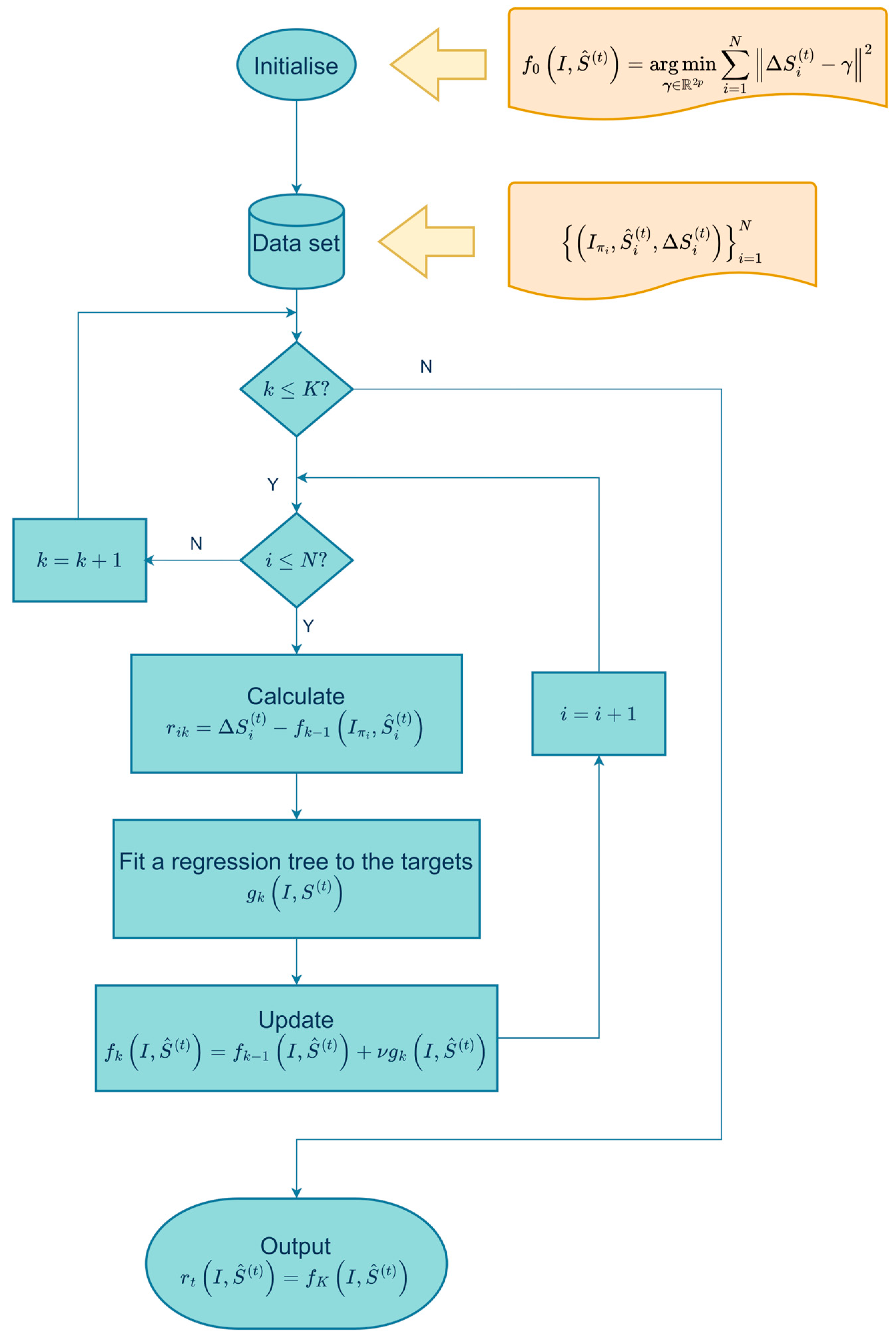
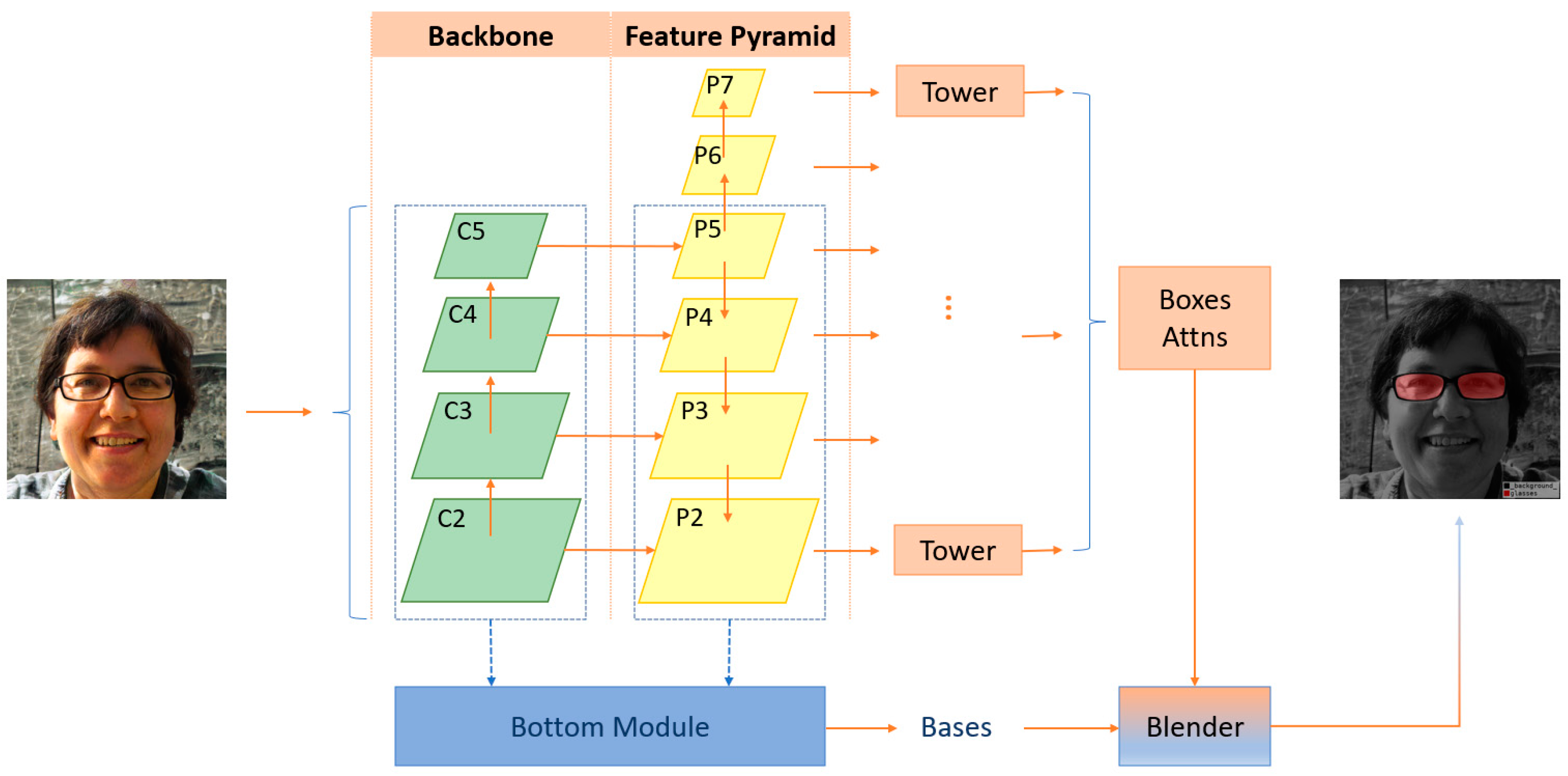
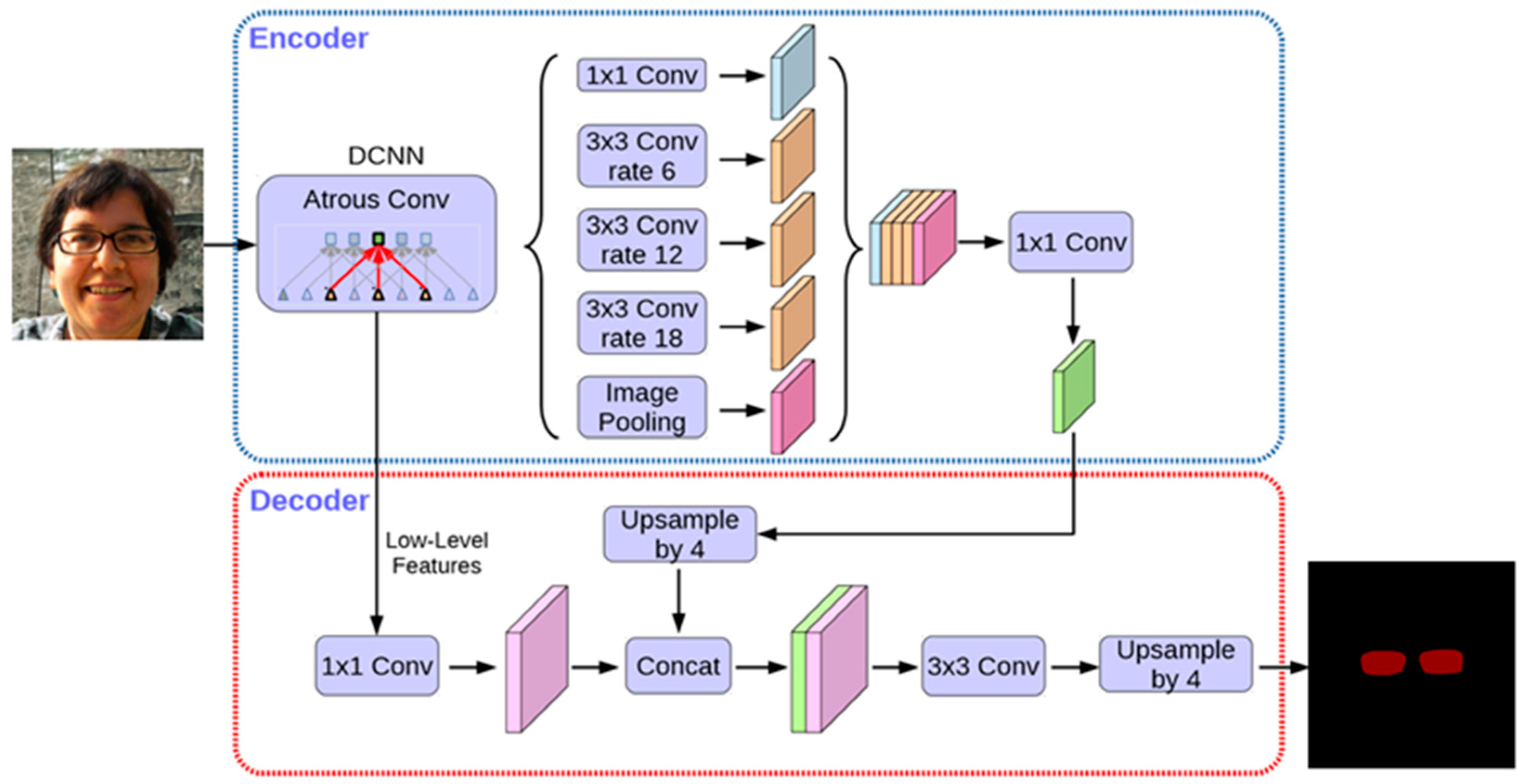


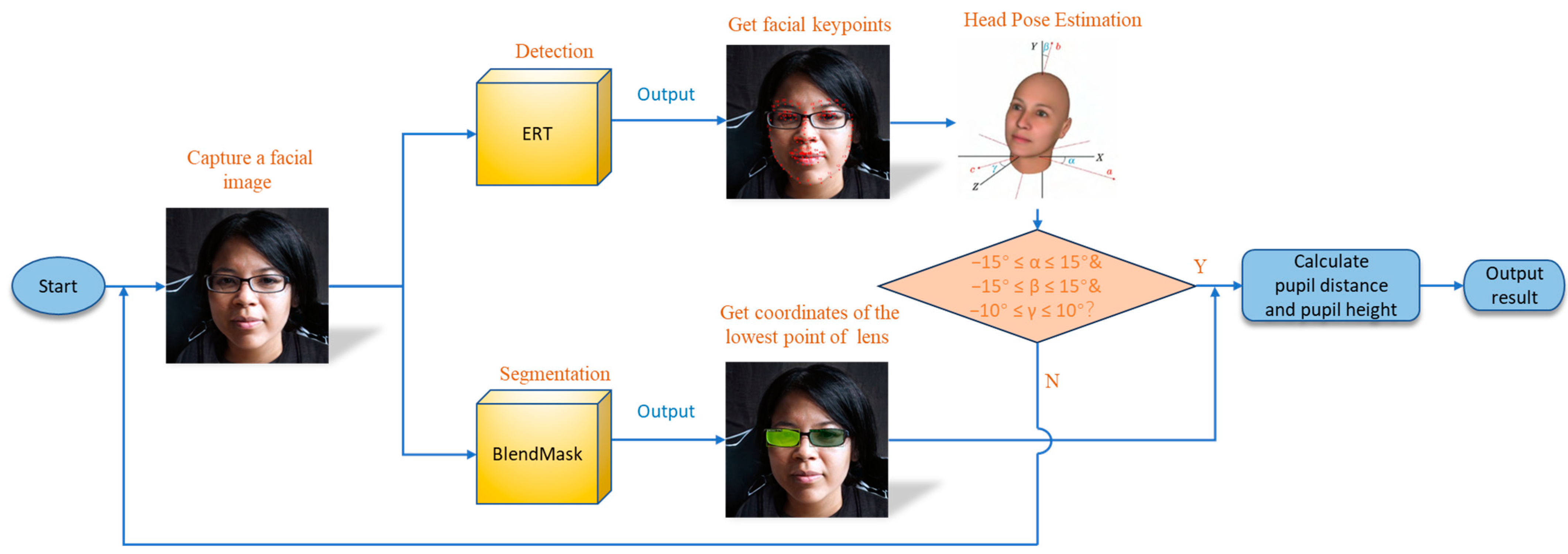


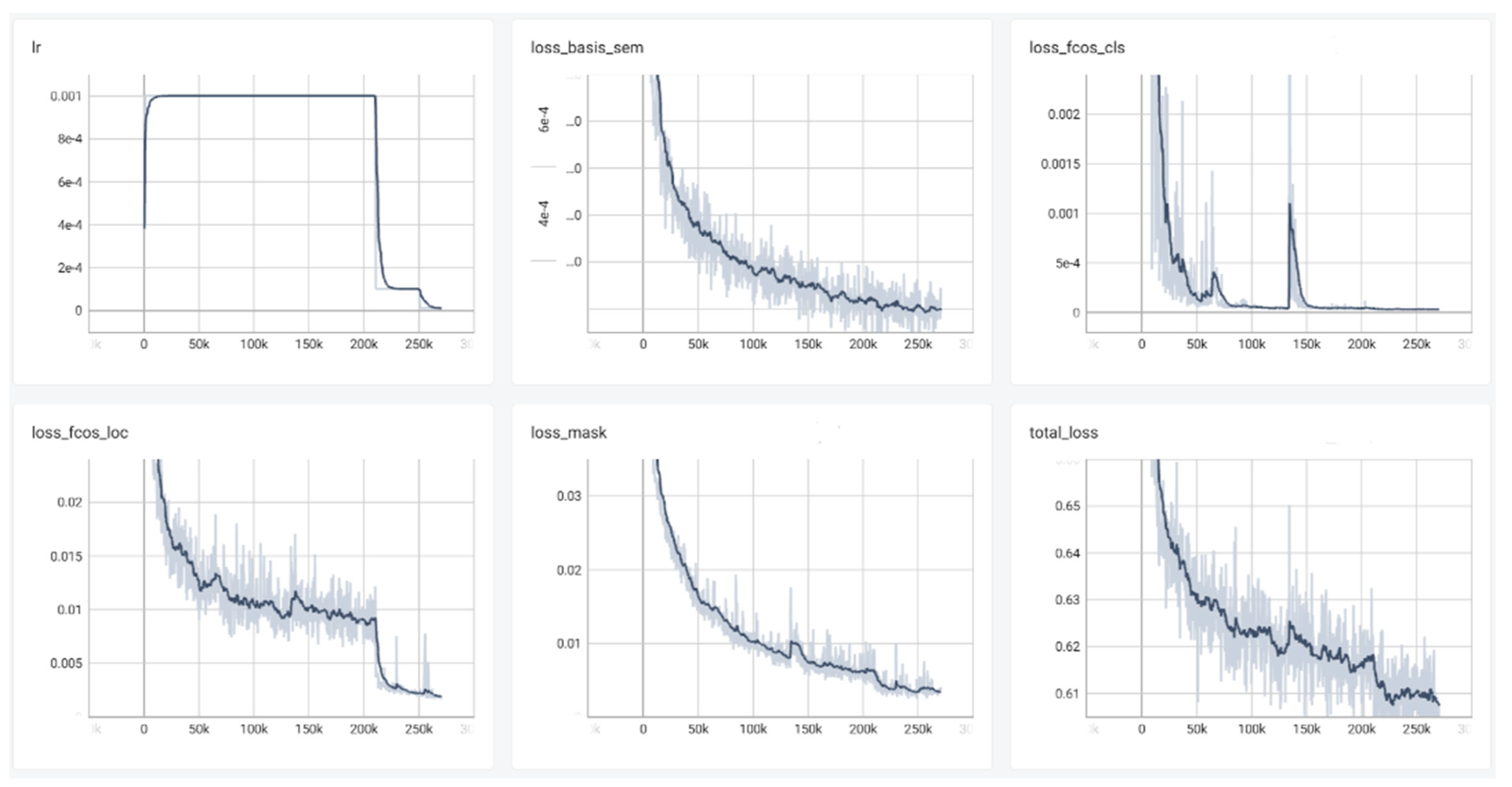
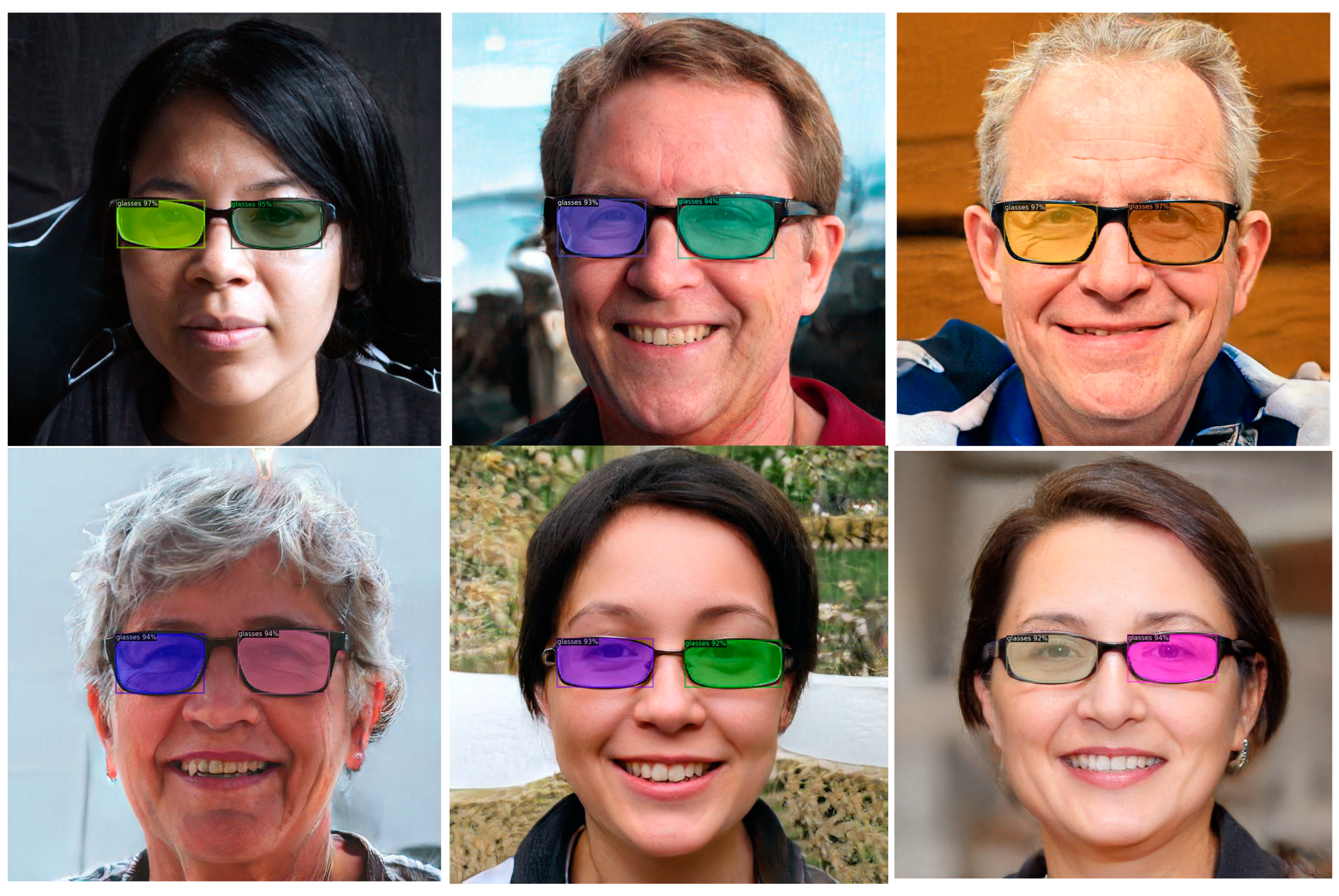
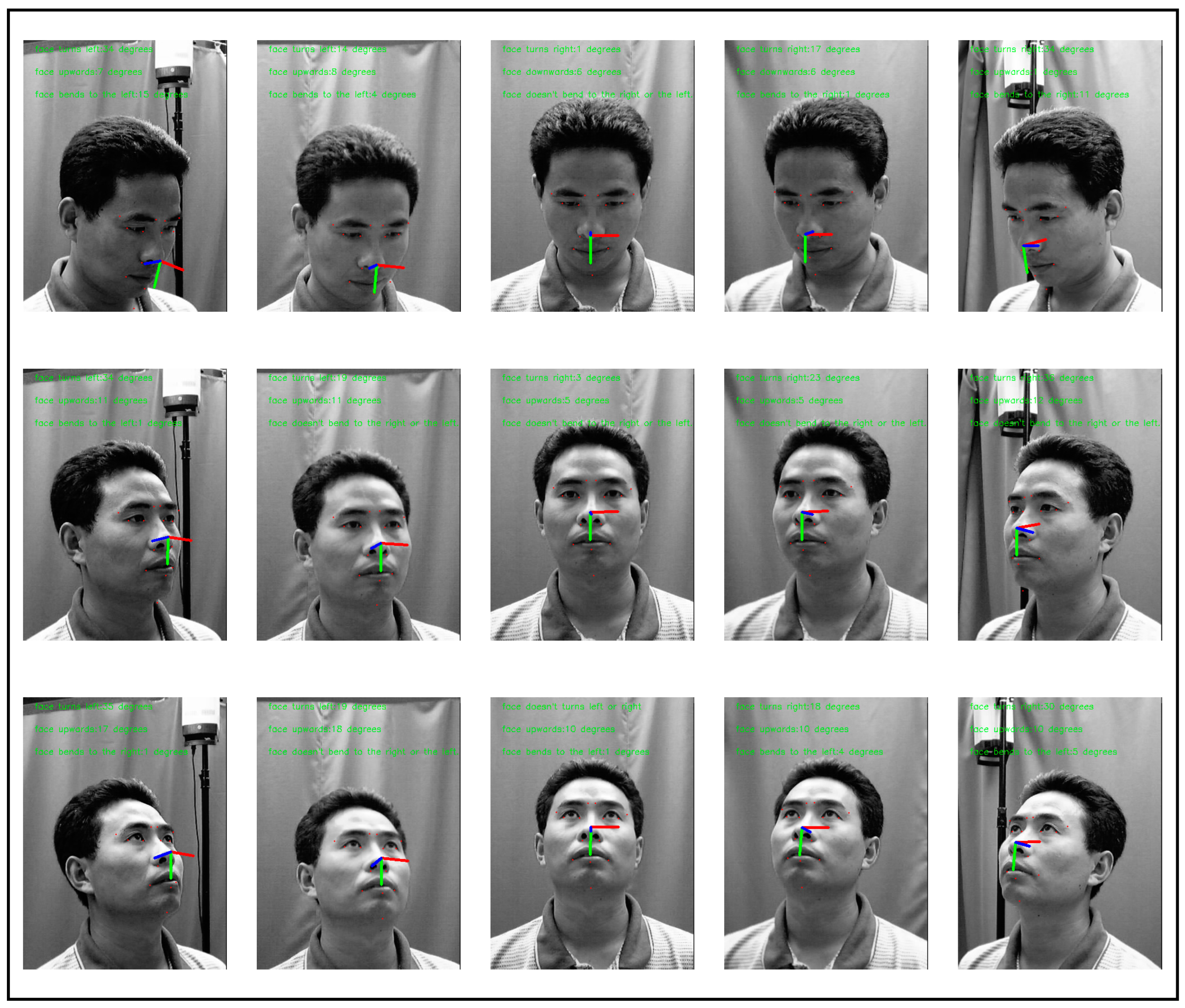
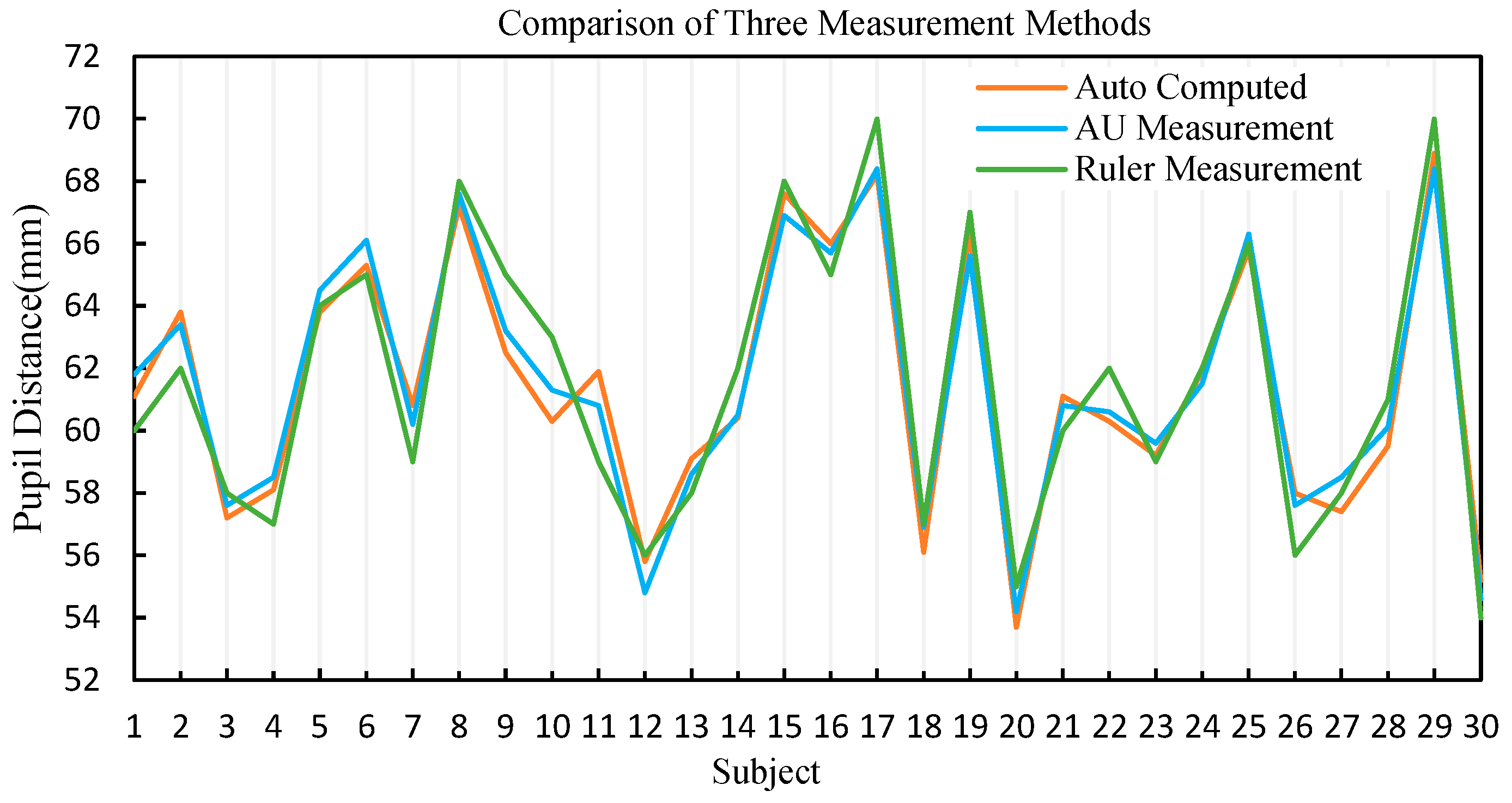
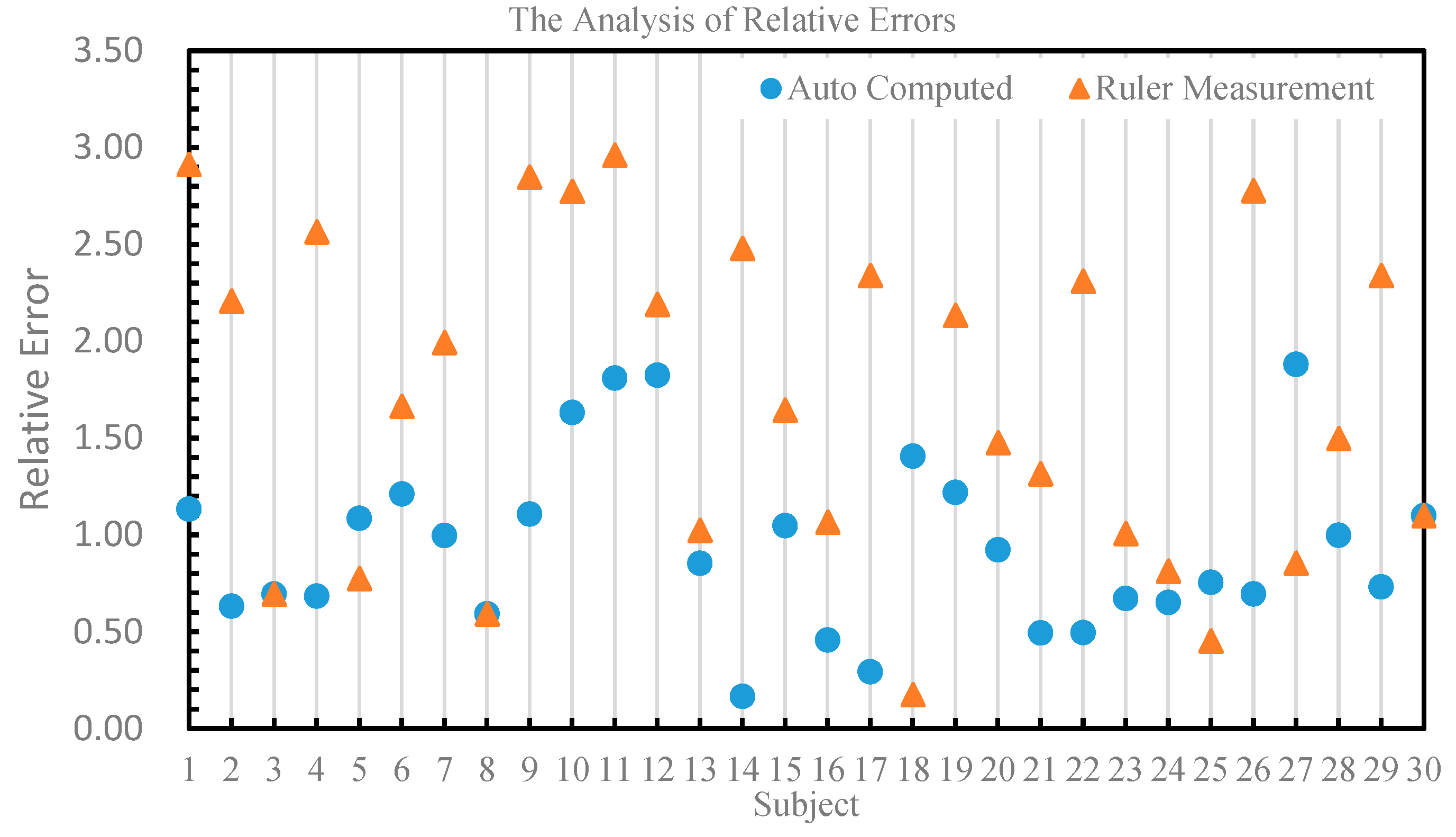
| Computer Configuration | Version |
|---|---|
| CPU | GenIntel®Core™ i7-11700F@ 2.50 GHz |
| RAM | 32 GB |
| GPU | NVIDIA GeForce RTX 3070Ti |
| Operating System | Win10 operating system |
| Framework | Pytorch |
| Parameters | Values |
|---|---|
| Cascade_depth | 10 |
| Tree_depth | 4 |
| Num_trees_per_cascade_level | 500 |
| Oversampling_amount | 20 |
| Feature_pool_size | 1000 |
| Lambda | 0.1 |
| Num_test_splits | 20 |
| Subject | Computed (mm) | AU Measurement (mm) | Ruler Measurement (mm) |
|---|---|---|---|
| 1 | 61.1 | 61.8 | 60 |
| 2 | 63.8 | 63.4 | 62 |
| 3 | 57.2 | 57.6 | 58 |
| 4 | 58.1 | 58.5 | 57 |
| 5 | 63.8 | 64.5 | 64 |
| 6 | 65.3 | 66.1 | 65 |
| 7 | 60.8 | 60.2 | 59 |
| 8 | 67.2 | 67.6 | 68 |
| 9 | 62.5 | 63.2 | 65 |
| 10 | 60.3 | 61.3 | 63 |
| 11 | 61.9 | 60.8 | 59 |
| 12 | 55.8 | 54.8 | 56 |
| 13 | 59.1 | 58.6 | 58 |
| 14 | 60.4 | 60.5 | 62 |
| 15 | 67.6 | 66.9 | 68 |
| 16 | 66 | 65.7 | 65 |
| 17 | 68.2 | 68.4 | 70 |
| 18 | 56.1 | 56.9 | 57 |
| 19 | 66.4 | 65.6 | 67 |
| 20 | 53.7 | 54.2 | 55 |
| 21 | 61.1 | 60.8 | 60 |
| 22 | 60.3 | 60.6 | 62 |
| 23 | 59.2 | 59.6 | 59 |
| 24 | 61.9 | 61.5 | 62 |
| 25 | 65.8 | 66.3 | 66 |
| 26 | 58 | 57.6 | 56 |
| 27 | 57.4 | 58.5 | 58 |
| 28 | 59.5 | 60.1 | 61 |
| 29 | 68.9 | 68.4 | 70 |
| 30 | 55.2 | 54.6 | 54 |
| Ruler Measurement | AU Measurement | Our Measurement Method | |
|---|---|---|---|
| Accuracy | Average | Excellent | Excellent |
| Cost | Very low | High | Low |
| Portability | Portable | Non-portable | Portable |
| Operation | Complex | Easy | Easy |
| Others | The operation process is complex, requires manual measurement, and takes a long time. | It requires professional personnel and equipment, but the process is relatively fast. | It can be embedded into various devices equipped with cameras, requiring no specialized operators and providing quick measurement results. |
Disclaimer/Publisher’s Note: The statements, opinions and data contained in all publications are solely those of the individual author(s) and contributor(s) and not of MDPI and/or the editor(s). MDPI and/or the editor(s) disclaim responsibility for any injury to people or property resulting from any ideas, methods, instructions or products referred to in the content. |
© 2023 by the authors. Licensee MDPI, Basel, Switzerland. This article is an open access article distributed under the terms and conditions of the Creative Commons Attribution (CC BY) license (https://creativecommons.org/licenses/by/4.0/).
Share and Cite
Zhang, Z.; Xiang, H.; Li, D.; Leng, C. Measurement Method of Interpupillary Distance and Pupil Height Based on Ensemble of Regression Trees and the BlendMask Algorithm. Appl. Sci. 2023, 13, 8628. https://doi.org/10.3390/app13158628
Zhang Z, Xiang H, Li D, Leng C. Measurement Method of Interpupillary Distance and Pupil Height Based on Ensemble of Regression Trees and the BlendMask Algorithm. Applied Sciences. 2023; 13(15):8628. https://doi.org/10.3390/app13158628
Chicago/Turabian StyleZhang, Zhenkai, Huiyu Xiang, Dongyang Li, and Chongjie Leng. 2023. "Measurement Method of Interpupillary Distance and Pupil Height Based on Ensemble of Regression Trees and the BlendMask Algorithm" Applied Sciences 13, no. 15: 8628. https://doi.org/10.3390/app13158628
APA StyleZhang, Z., Xiang, H., Li, D., & Leng, C. (2023). Measurement Method of Interpupillary Distance and Pupil Height Based on Ensemble of Regression Trees and the BlendMask Algorithm. Applied Sciences, 13(15), 8628. https://doi.org/10.3390/app13158628






